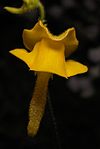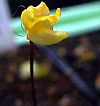Classification System: APG IV
Superregnum: Eukaryota
Regnum: Plantae
Cladus: Angiosperms
Cladus: Eudicots
Cladus: Core eudicots
Cladus: Asterids
Cladus: Lamiids
Ordo: Lamiales
Familia: Lentibulariaceae
Genus: Genlisea
Subgenera: G. subg. Genlisea – G. subg. Tayloria
Overview of species
G. africana – G. angolensis – G. aurea – G. barthlottii – G. exhibitionista – G. filiformis – G. flexuosa – G. glabra – G. glandulosissima – G. guianensis – G. hispidula – G. lobata – G. margaretae – G. metallica – G. nebulicola – G. nigrocaulis – G. oligophylla – G. pallida – G. pygmaea – G. repens – G. roraimensis – G. sanariapoana – G. stapfii – G. subglabra – G. tuberosa – G. uncinata – G. violacea
Name
Genlisea A. St.-Hil., Voy. Distr. Diam. ii. 428 (1883)
Type species: Genlisea aurea A. Saint-Hilaire Voy. Distr. Diam. ii. 428 (1883) vide Barnhart, Mem. New York Bot. Gard. 6: 48. (1916)
Distribution
Native distribution areas:
Africa
West Tropical Africa
Burkina, Gambia, Guinea-Bissau, Guinea, Ivory Coast, Liberia, Mali, Nigeria, Senegal, Sierre Leone.
West-Central Tropical Africa
Burundi, Central African Republic, Cameroon, Congo, Gabon, Zaïre.
East Tropical Africa
Kenya, Tanzania.
South Tropical Africa
Angola, Malawi, Mozambique, Zambia, Zimbabwe.
Southern Africa
Cape Provinces, KwaZulu-Natal, Swaziland, Northern Provinces.
Western Indian Ocean
Madagascar.
Northern America
Mexico
Mexico Southeast.
Southern America
Central America
Belize, Honduras, Nicaragua.
Caribbean
Cuba, Trinidad-Tobago.
Northern South America
French Guiana, Guyana, Suriname, Venezuela.
Western South America
Bolivia, Colombia.
Brazil
Brazil West-Central, Brazil Northeast, Brazil Southeast, Brazil North, Brazil South.
Southern South America
Paraguay.
References: Brummitt, R.K. 2001. TDWG – World Geographical Scheme for Recording Plant Distributions, 2nd Edition
References
Links
Govaerts, R. et al. 2018. Genlisea in World Checklist of Selected Plant Families. The Board of Trustees of the Royal Botanic Gardens, Kew. Published on the internet. Accessed: 2018 Nov. 6. Reference page.
Tropicos.org 2012. Genlisea. Missouri Botanical Garden. Published on the internet. Accessed: 2012 July 10.
International Plant Names Index. 2012. Genlisea. Published online. Accessed: July 10 2012.
Vernacular names
čeština: Genliseje
Deutsch: Reusenfallen
English: Corkscrew plants
日本語: ゲンリセア属
മലയാളം: ജെൻലിസിയ
中文: 螺旋狸藻屬
Genlisea (/ˌdʒɛnlɪˈsiːə/ JEN-liss-EE-ə) is a genus of carnivorous plants also known as corkscrew plants. The 30 or so species grow in wet terrestrial to semi-aquatic environments distributed throughout Africa and Central and South America. The plants use highly modified underground leaves to attract, trap and digest minute microfauna, particularly protozoans. Although suggested a century earlier by Charles Darwin, carnivory in the genus was not proven until 1998.[1]
The generic name Genlisea honors the French writer and educator Stéphanie Félicité Ducrest de St-Albin, comtesse de Genlis.[2]
Several species in the genus, including G. margaretae, G. aurea, and G. tuberosa, possess the smallest known genomes of all flowering plants.[3][4][5]
Description
Genlisea subglabra leaves
Genlisea are small herbs, growing from a slender rhizome and bearing two morphologically distinct leaf types - photosynthetic foliage leaves aboveground and highly modified subterranean leaves used to trap prey. The plants lack roots, although the subterranean traps perform many of the functions normally performed by roots, such as anchorage and absorption of water and nutrients.
Several to many flowers are held by a slender, erect, and often tall inflorescence. As in other members of the bladderwort family, the corolla is fused into a bilobed tube tapering to a spur, with the lower lip of the corolla having three lobes.[2] The calyx is five-lobed, in contrast to Utricularia's three-lobed calyx.[6] Corolla colors are generally yellow or violet to mauve, although a few species are white or cream.[6]
Plate from "Handbuch der Systematischen Botanik", 1. Spirally coiled tube-leaf of Genlisea aurea 2. Longitudinal section of tube, showing retrorse hairs
Depending on species, the photosynthetic leaves are linear to spatulate in shape and 0.5–5 cm (¼–2 in) in length.[2]
The subterranean traps are white, lacking chlorophyll or any other pigmentation. They consist of a cylindrical stalk, widening at some distance below the surface into a hollow bulb-like utricle, and continuing as a hollow cylinder some further distance. At this point the stalk bifurcates into two furrowed spirals, between which the cylinder opening acts as the trap entrance. The furrows of the spiraled trap arms are lined with hairs pointing inward and toward the bifurcation. The hollow cylinder section leading from the bifurcation to the utricle is likewise lined with upward-pointing curved hairs. Some species produce two trap forms, one shorter and one longer, which probably target different prey groups.
Taxonomy
Twenty-nine species are currently recognised in the genus.[7] Two varieties are also considered valid: G. aurea var. minor and the autonymous G. aurea var. aurea.[7] Intraspecific determination depends almost wholly upon the inflorescence, particularly upon the indumentum.[6]
| Species | Authority | Year | Image | Distribution | Subgenus | Section | Genome size (Mbp)[5] |
|---|---|---|---|---|---|---|---|
| Genlisea africana | Oliv. | 1865 | Africa | Genlisea | Africanae | 740 | |
| Genlisea angolensis | R.D.Good | 1924 | Africa | Genlisea | Africanae | - | |
| Genlisea aurea | A.St.-Hil. | 1833 |  |
South America | Genlisea | Genlisea | 64 & 117 - 131 |
| Genlisea barthlottii | S.Porembski, Eb.Fisch. & Gemmel | 1996 | Africa | Genlisea | Africanae | - | |
| Genlisea exhibitionista[8] | Rivadavia & A.Fleischm. | 2011 | South America | Tayloria | - | ||
| Genlisea filiformis | A.St.-Hil. | 1833 |  |
South America, Central America, Cuba | Genlisea | Genlisea | - |
| Genlisea flexuosa[8] | Rivadavia, A.Fleischm. & Gonella | 2011 | South America | Tayloria | - | - | |
| Genlisea glabra | P.Taylor | 1967 | South America | Genlisea | Genlisea | - | |
| Genlisea glandulosissima | R.E.Fr. | 1916 | Africa | Genlisea | Recurvatae | 154-189 | |
| Genlisea guianensis | N.E.Br. | 1900 | South America | Genlisea | Genlisea | 289 | |
| Genlisea hispidula | Stapf | 1904 |  |
Africa | Genlisea | Africanae | 1510 - 1550 |
| Genlisea lobata | Fromm | 1989 |  |
South America | Tayloria | - | 1200 - 1722 |
| Genlisea margaretae | Hutch. | 1946 | Africa, Madagascar | Genlisea | Recurvatae | 113 - 195 | |
| Genlisea metallica[8] | Rivadavia & A.Fleischm. | 2011 | South America | Tayloria | - | 1057 | |
| Genlisea nebulicola[8] | Rivadavia, Gonella & A.Fleischm. | 2011 | South America | Tayloria | - | - | |
| Genlisea nigrocaulis | Steyerm. | 1948 | South America | Genlisea | Genlisea | 73 - 86 | |
| Genlisea oligophylla[8] | Rivadavia & A.Fleischm. | 2011 | South America | Tayloria | - | - | |
| Genlisea oxycentron | P.Taylor | 1954 | South America, Trinidad | Genlisea | Genlisea | 75 | |
| Genlisea pallida | Fromm & P.Taylor | 1985 | Africa | Genlisea | Recurvatae | - | |
| Genlisea pulchella | Tutin | 1934 | South America | Genlisea | Genlisea | - | |
| Genlisea pygmaea | A.St.-Hil. | 1833 |  |
South America | Genlisea | Genlisea | 161 - 179 |
| Genlisea repens | Benj. | 1847 |  |
South America | Genlisea | Genlisea | 77 - 86 & 142 - 150 |
| Genlisea roraimensis | N.E.Br. | 1901 | South America | Genlisea | Genlisea | - | |
| Genlisea sanariapoana | Steyerm. | 1953 | South America | Genlisea | Genlisea | - | |
| Genlisea stapfii | A.Chev. | 1912 | Africa | Genlisea | Africanae | - | |
| Genlisea subglabra | Stapf | 1906 |  |
Africa | Genlisea | Africanae | 1471 - 1622 |
| Genlisea tuberosa[9] | Rivadavia, Gonella & A.Fleischm. | 2013 | South America | Genlisea | Genlisea | 61[4] | |
| Genlisea uncinata | P.Taylor & Fromm | 1983 | South America | Tayloria | - | 995 - 1062 | |
| Genlisea violacea | A.St.-Hil. | 1833 |  |
South America | Tayloria | - | 1005 - 1609 |
Botanical history
The genus was discovered by Augustin François César Prouvençal de Saint-Hilaire,[2] who in 1833 described four species: G. aurea, G. filiformis, G. pygmaea, and G. violacea.
Genome size range
The genus has a 25-fold range in genome size among its species and notably includes some of the smallest known plant genomes.[5] For example, the genome of G. nigrocaulis is 86 Mbp (1C; 2n = 40) while that of its close relative G. hispidula (1C; 2n = 40) is 1550 Mbp, 18-fold larger. More than one genome size has been measured in G. aurea and G. repens, suggesting that di- and tetraploid individuals exist.[5]
References
Barthlott W, Porembski S, Fischer E, Gemmel B (1998). "First protozoa-trapping plant found". Nature. 392 (6675): 447. doi:10.1038/33037. PMID 9548248.
Claudi-Magnussen G (1982). "An introduction to Genlisea". Carnivorous Plant Newsletter. 11 (1): 13–15.
Greilhuber J, Borsch T, Müller K, Worberg A, Porembski S, Barthlott W (2006). "Smallest angiosperm genomes found in Lentibulariaceae, with chromosomes of bacterial size". Plant Biology. 8: 770–777. doi:10.1055/s-2006-924101. PMID 17203433.
Fleischmann A, Michael TP, Rivadavia F, Sousa A, Wang W, Temsch EM, Greilhuber J, Müller KF, Heubl G (2014). "Evolution of genome size and chromosome number in the carnivorous plant genus Genlisea (Lentibulariaceae), with a new estimate of the minimum genome size in angiosperms". Annals of Botany. 114 (8): 1651–1663. doi:10.1093/aob/mcu189. PMC 4649684. PMID 25274549.
Vu, Giang; Schmutzer, Thomas; Bull, Fabian; Cao, Hieu; Fuchs, Jörg; Schubert, Ingo; others, and (2015). "Comparative Genome Analysis Reveals Divergent Genome Size Evolution in a Carnivorous Plant Genus". The Plant Genome. 8 (3): 1–14. doi:10.3835/plantgenome2015.04.0021. Retrieved 30 November 2018.
Taylor P (1991). "The genus Genlisea". Carnivorous Plant Newsletter. 20 (1–2): 20–26.
Fleischmann, A. (2012). Monograph of the Genus Genlisea. Redfern Natural History Productions, Poole. ISBN 978-190-878-700-2.
Fleischmann, A., F. Rivadavia, P.M. Gonella & G. Heubl (2011). A revision of Genlisea subgenus Tayloria (Lentibulariaceae). Phytotaxa 33: 1–40. first page
Rivadavia F, Gonella PM, Fleischmann A (2013). "A new and tuberous species of Genlisea (Lentibulariaceae) from the campos rupestres of Brazil". Systematic Botany. 38 (2): 464–470. doi:10.1600/036364413X666679.
Płachno BJ, Kozieradzka-Kiszkurno M, Świątek P (2007). "Functional ultrastructure of Genlisea (Lentibulariaceae) digestive hairs". Annals of Botany. 100 (2): 195–203. doi:10.1093/aob/mcm109. PMC 2735322. PMID 17550910.
Retrieved from "http://en.wikipedia.org/"
All text is available under the terms of the GNU Free Documentation License

